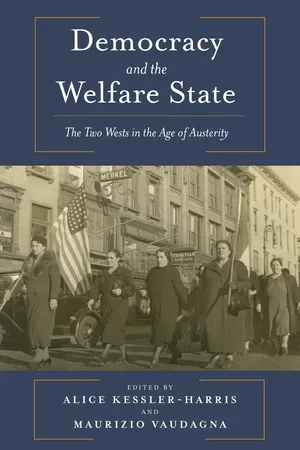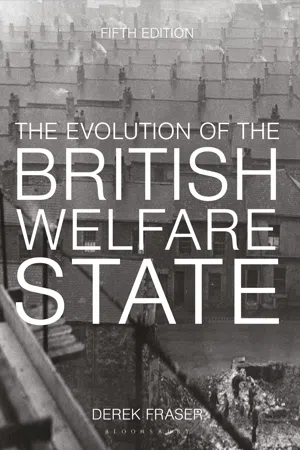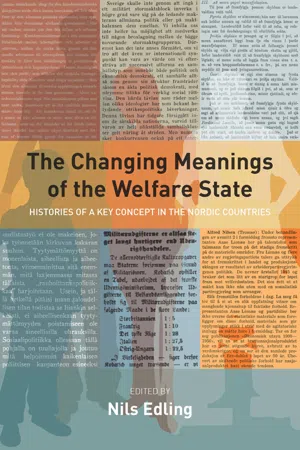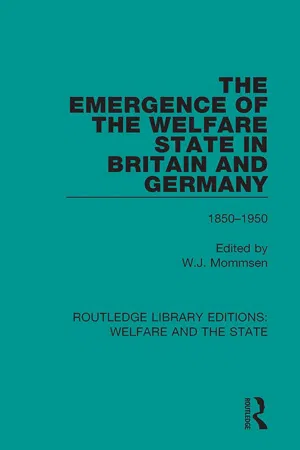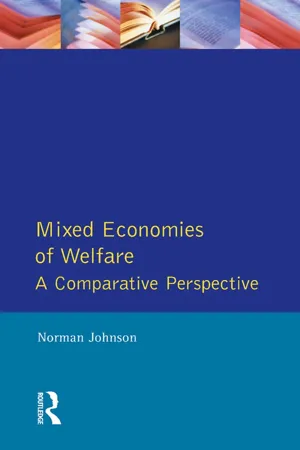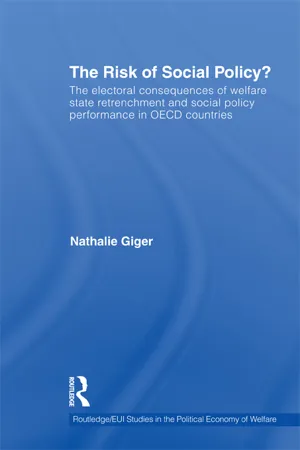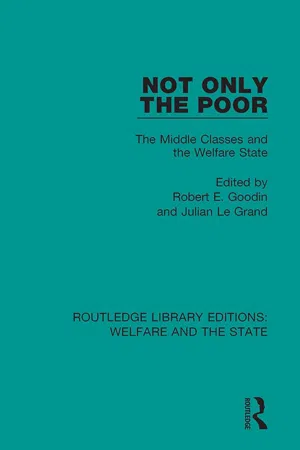History
The Welfare State
The welfare state refers to a system in which the government takes responsibility for the social and economic well-being of its citizens. It typically involves providing social services such as healthcare, education, unemployment benefits, and pensions. The concept gained prominence in the 20th century as a response to the challenges of industrialization, urbanization, and social inequality.
Written by Perlego with AI-assistance
Related key terms
Related key terms
1 of 4
Related key terms
1 of 3
11 Key excerpts on "The Welfare State"
- eBook - ePub
Democracy and the Welfare State
The Two Wests in the Age of Austerity
- Alice Kessler-Harris, Maurizio Vaudagna(Authors)
- 2017(Publication Date)
- Columbia University Press(Publisher)
CHAPTER ONE Historians Interpret The Welfare State, 1975–1995 MAURIZIO VAUDAGNA SOCIAL SCIENTISTS AND HISTORIANS WRITE THE HISTORY OF The Welfare StateAfter more than a half-century of modern social policies, World War II ushered in an era that witnessed the marriage of Keynesian economics and social security.1 The notion of the “welfare state” emerged as a political, social, and economic order where the state played a key role in protecting and promoting the economic and social well-being of its citizens. Its definition fell within two clusters of meaning: on the one hand, The Welfare State was a “mixed system” of public/private economic cooperation that fostered a policy of growth and full employment and, on the other, it promised a protective policy of socioeconomic security. As a result, the idea of justice expanded to include new meanings: “social justice” and “social rights” became qualities of democratic citizenship as essential to the individual as civil, personal, and political rights.After World War II, historicist social scientists initiated and went on to dominate the field of social policy and welfare-state history. For the most part, they interpreted that history with a pronounced presentist vision of the past. Founded by the British public intellectual Richard Titmuss, the social-science approach aimed to explain the links connecting “modernization,” liberal democracy, and social provision.2 The egalitarian wartime social services, Titmuss argued, reflected the sense of solidarity held by families and communities, fed the principle of equal citizenship, and powerfully contributed to the victory of freedom.Titmuss inaugurated a trend in social scientists’ historical explorations of The Welfare State that has continued to this day. Endless examples could be cited. For example, since the 1960s the Swedish sociologist Walter Korpi has embraced a neo-Marxist interpretation of the democratic class struggle as the core of the social-democratic welfare state.3 In 1971, the American economist Gaston Rimlinger published a comprehensive study of the historical traditions that had originated different transatlantic “paths” to social security.4 Equally comparative was the book published in 1981 by the joint U.S.-German research group led by the sociologists Peter Flora and Arnold J. Heidenheimer.5 Their interpretation joined the substantial ranks of publications by scholars who thought of The Welfare State as a functional necessity of modern liberal capitalism. In particular, Flora and Heidenheimer focused on the social state as “an answer to increasing demands for socioeconomic equality in the context of the evolution of mass democracies.”6 - eBook - ePub
The Evolution of the British Welfare State
A History of Social Policy since the Industrial Revolution
- Derek Fraser(Author)
- 2017(Publication Date)
- Bloomsbury Academic(Publisher)
© Derek Fraser 2017 Derek Fraser The Evolution of the British Welfare State https://doi.org/10.1057/978-1-137-60589-4_1Begin AbstractEnd Abstract1. Introduction: Perspectives on the history of welfare
The Welfare State is a concept which historians and sociologists alike have found difficult to define. Like socialism, it has meant different things to different people. As the distinguished social scientist W. A. Robson has remarked, it is not easy ‘to discover what is the nature of The Welfare State … there is no positive or comprehensive philosophy, no ideology that underlies The Welfare State … the term … does not designate a definite system.’ Similarly, the welfare historian Rodney Lowe admits, ‘There is no agreement amongst historians and social scientists over when the first welfare states were established or what the term actually means’, or as David Garland expresses it, ‘welfare states are familiar, even mundane, but their true character remains elusive.’1 Some features of The Welfare State in practice are clear, however. It is a system of social organisation which restricts free market operations in three principal ways: by the designation of certain groups, such as children or factory workers, whose rights are guaranteed and whose welfare is protected by the community; by the delivery of services such as medical care or education, so that no citizen shall be deprived of access to them; and by transfer payments which maintain income in times of exceptional need, such as parenthood, or of interruption of earnings caused by such things as sickness or unemployment. The history of social policy is concerned with these three areas and we shall find that it was not always believed that the protection of vulnerable groups, the provision of social services or the maintenance of income were the responsibility of the state. As Welfare States became features of many modern societies, social scientists have sought to define a typology. Esping-Andersen (1990 - eBook - ePub
The Changing Meanings of the Welfare State
Histories of a Key Concept in the Nordic Countries
- Nils Edling(Author)
- 2019(Publication Date)
- Berghahn Books(Publisher)
However, the comprehensive and multifaceted criticism towards the idea of The Welfare State was to a large degree also a criticism towards the Social Democrats and their social reform agenda. So, other party members felt obliged to defend The Welfare State against what they considered ideological and misleading criticism. They tried to specify the meaning in ways that had positive connotations and aligned with social democracy:The Welfare State is a society that protects all citizens against political and economic suppression and ensures security from the cradle towards the grave.76The core of The Welfare State is the same as characterized the Stauning-period (1929–1942): Denmark for the people . . . it is not the citizens’ nanny, but a creator of social security and employment setting human worth in the high seat.77The objective of The Welfare State is to provide greater equality of opportunities and conditions.78The Welfare State is a society in which the citizens’ security and respect for the welfare of all individuals are the objectives of the economic, social and cultural policy . . . The Welfare State is not static, but a continuous march towards happier conditions of life.79The Welfare State ‘acknowledges social solidarity as a natural component of national solidarity’.80Even though The Welfare State was enlarged and developed from one social reform to the next, the Social Democrats did not succeed in making The Welfare State (as a concept) popular, and from the end of the 1950s the term was toned down in the political rhetoric of the party. In 1960, the Minister of Finance, Viggo Kampmann, asked whether The Welfare State merely was a scapegoat in line with ministers of finance and other unpopular terms.81During the 1960s the term did not disappear from Social Democratic language, but it was used infrequently only and in such cases often in connection with assertions that without this or that social reform Denmark would not be a welfare state. The term ‘welfare state’ did not appear in the Social Democratic programme of principles from 1961.82 - eBook - ePub
- Thomas Wilson, Dorothy J. Wilson(Authors)
- 2021(Publication Date)
- Routledge(Publisher)
The Welfare State: Its Meaning and its DevelopmentThe Importance of The Welfare State
The title of this book – The Political Economy of The Welfare State – requires at the outset some explanation and comment. The familiar expression ‘welfare state’ came into general colloquial use about half a century ago. Although its boundaries have not been firmly and clearly delineated and are drawn rather more widely by some commentators than by others, there is no doubt or disagreement about its central territories. These include, first, the various social security transfer payments: retirement pensions, widows pensions, invalidity pensions, unemployment pay, sickness benefit, child benefits and so on. Secondly, there are the benefits in kind from the health service and the personal social services. The third category is state-financed education. Fourthly, some of the subsidies provided by government are usually included, such as the subsidization of school meals or of the rents of public housing. There are various other subsidies that would not normally be included, such as those given to agriculture or other particular industries, but the boundary becomes hard to discern. Some people would wish to include, for example, subsidies for industrial development in the less prosperous areas; others would not. The subsidization of public transport is another debatable case. The uncertainty increases when we turn to the fifth category: special tax allowances or ‘tax-expenditures’, as they are now, somewhat misleadingly, called. Such allowances may be substitutes for cash grants, although the effects will not usually be identical. Thus families may be helped by means of child benefits or by means of tax allowances for children. Or, to take another example, it will not do to confine attention to rent subsidies to the neglect of allowances against the mortgages of owner-occupiers. With tax allowances, as with subsidies, there are borderline cases. To quote from two authors who have devoted detailed attention to the subject: ‘The choice of the term "tax expenditure" indicates that, because they are not inherent in the structure of the tax, these reliefs are equivalent in terms of revenue foregone to direct government expenditure and should be judged by the same criterion.’1 - eBook - ePub
- Wolfgang Mommsen(Author)
- 2018(Publication Date)
- Routledge(Publisher)
PART FOURPAST AND FUTURE OF The Welfare State IN SOCIAL-SCIENTIFIC PERSPECTIVE
Passage contains an image
P. Flora16 SOLUTION OR SOURCE OF CRISES? The Welfare State IN HISTORICAL PERSPECTIVE1The modern welfare state had its beginnings in Europe about a century ago, and it has since been a central element in the profound changes which European societies have undergone – and will have to master in future. The basic aim of The Welfare State was a ‘defensive policy of integration and stabilisation’. In the sense of preserving existing structures, welfare state policy long remained defensive and to a large extent still does. But the answers to the questions of who was to be integrated and what had to be stabilised have changed.Initially, the policy of integration was directed exclusively at the working class, whose militancy against the system was to be restrained and channelled, and it was the capitalist economic system and the prevailing political order that was to be stabilised. Today, The Welfare State has grown far beyond the working class and lost its purely defensive character, but integration and stabilisation still remain central functions.Since its inception the idea of The Welfare State has rarely been a truly inspiring ideal; its success as a mobilising force can hardly be compared with that of nationalism or socialism. Only once, in the troubled England of the Second World War, inspired by Beveridge’s pen, did it generate an enthusiasm that found a considerable echo in the Anglo-Saxon world. From the beginning, The Welfare State obviously had its enemies as well as its sceptics. Some thought it did too little, others too much; some saw it as the beginning of revolutionary change, others feared it might paralyse revolutionary impetus. Neither Marxists nor the followers of Durkheim were able to accept The Welfare State as an adequate solution to the problems posed by the crisis of European societies, of which their diagnoses diverged widely. Beyond that, there had always existed the fear that The Welfare State might undermine the will to work, hinder economic productivity and the capacity for innovation, and place too large a burden on the public purse. The question of limits has accompanied The Welfare State ever since its modest beginnings. - eBook - ePub
- Robert Johns(Author)
- 2011(Publication Date)
- Learning Matters(Publisher)
The End of the Poor Law and a New Beginning Robert JohnsAchieving a Social Work or Social Policy Degree Exercises in this chapter will focus onskill 3 relating different views to underlying philosophies or ideologiesskill 4 evaluating different perspectives and ideasThe chapter is relevant to a number of Social Policy Benchmarks.3.2 origins and development of UK welfare institutions and the social and demographic contexts in which they have operated main features of the interrelationship between social policies and differently placed communities, families and individuals3.3 key concepts and theories of welfare theories of the state and policymaking history of contemporary social problems and of social policy responses to themIts content is also of particular relevance to the following Social Work Subject Benchmarks.5.1.2 the location of contemporary social work within historical, comparative and global perspectives the changing demography and cultures of communities the complex relationships between public, social and political philosophies, policies and priorities and the organisation and practice of social workIntroduction
When people mention the ‘welfare’, they sometimes appear to be talking about the benefit system, but are occasionally referring to the role of social workers. Occasionally they get the two mixed up and do not distinguish between them at all. To some extent this is understandable. In many people’s minds social work is associated with The Welfare State –comprehensive government intervention intended to improve people’s well-being: financial, educational, physical and social. Social work is clearly aimed at the social, but it is not surprising that people see the whole welfare state as a package and automatically make certain kinds of connections, so linking social care and well-being with state benefits that help people avoid poverty is logical. This logic is confirmed by history, for many of the developments that comprise The Welfare State – the National Health Service, the social security and benefit system, the development of secondary education, and the establishment of social work as primarily a local authority service – occurred during a comparatively short period, 1946–1948. - eBook - ePub
Welfare Beyond the Welfare State
The Employment Relationship in Britain and Germany
- Felix Behling(Author)
- 2018(Publication Date)
- Palgrave Macmillan(Publisher)
With few exceptions, the debates take industrialisation as the starting point for their analysis, arguing that this period gave rise to the development of an organised, national welfare system. Moreover, the state has been considered the natural unit of analysis in most of these works. This chapter takes a longer and broader view of welfare state development. On the one hand, authors such as Thane or Mommsen outline the historical origins of the two welfare states, reaching back as far as the Middle Ages. Guilds, parishes and other associations provided welfare to their members or to the local community, which sometimes amounted to significant levels of support relative to its size. How do these early welfare institutions relate to those of the industrial age or even the modern welfare state? On the other hand, we have seen in Chap. 2 that companies provided employee welfare benefits that were more than a mere supplement. The companies did this to attract, retain or reform their workers and they remained important until well into the twentieth century, when the state system was already advanced. Why did employee welfare persist and how did it affect the course of governmental welfare? The focus on industrialisation as the starting point for national welfare systems has been driven by the concerns and ideas raised during this period. State and civil society identified the social question or soziale Frage as one of the most pressing issues of the time (Flora and Heidenheimer 1981 ; Fraser 2003 ; Tilly 1992). The rise in wage labour led to a greater dependency of workers on the ability to find suitable employment, while the economic and social transformations of the time reduced capacities for non-market subsistence. The question was how to ensure adequate living standards for the mass of workers employed in industry and without any other means to provide for themselves; in other words, how to deal with the risks of industrial production - eBook - ePub
- Norman Johnson(Author)
- 2014(Publication Date)
- Routledge(Publisher)
Chapter 5 .The growth of state intervention
State involvement in welfare goes back several centuries, but The Welfare State as we understand it today can be traced back to the late nineteenth century. Kuhnle (1981, p. 126) states that ‘Most writers trace the initiation of The Welfare State, or at least the beginning of the present stage of development, to Bismarck's large-scale social insurance schemes of the last quarter of the nineteenth century’. Different countries developed services at different rates, at different times and with different priorities.Nevertheless, by 1900 Germany already had sickness insurance, industrial accident insurance and old age pensions. By 1911 every country in Western Europe had some form of workers' compensation scheme. In 1913 Sweden was the first country to introduce a pensions insurance scheme covering the entire population, but by that time Australia, Austria, Belgium, Denmark, France, Germany, Italy, The Netherlands, Norway, Switzerland and Britain all had some form of sickness insurance which financed both cash benefits and some health care services. Membership of the schemes was compulsory for certain categories of workers in Austria, Germany, The Netherlands, Norway and Britain; elsewhere membership was voluntary but with some subsidisation from the state. Unemployment insurance, introduced in Britain in 1911, came later elsewhere; for example, not until 1927 in Germany, not until 1935 in the United States, and not until 1944 in Canada.It would take far too long to chronicle the gradual and fitful development of The Welfare State from the nineteenth century to the present time, and I will now turn to the post-war period when all capitalist countries accepted the principle of The Welfare State, although to different extents and with varying degrees of enthusiasm. The foundations for The Welfare State laid during the sixty years before the outbreak of the Second World War were now consolidated as the range of state provision expanded. The late 1940s saw the beginning of a period of social reform which continued unabated until the end of the 1960s. This period may be considered the heyday of The Welfare State. In the immediate postwar period every capitalist country co-ordinated and extended its social security system, and benefits were increased. In West European countries coverage became increasingly comprehensive and universal. In the United States social security expanded more gradually than it did in Europe, and it was not until the 1960s that provision became a little less selective, and in 1965 Medicaid (for poorer people) and Medicare (for older people) were introduced. Almost everywhere expenditure on health and education rose absolutely and as a proportion of GDP. Housing programmes were launched in most countries, and governments began to take a more active role, through subsidies, loans and allowances. - eBook - ePub
- Nathalie Giger(Author)
- 2011(Publication Date)
- Routledge(Publisher)
2 Welfare state research
The theoretical background for theresearch question
The aim of this chapter is twofold. In the first part, a short review of the literature on welfare states and social policy retrenchment in particular is provided. In doing so, the theoretical background for the research question of this book is laid out in more detail; the main topic of this study is embedded in The Welfare State literature. Second, the literature on welfare state attitudes is discussed and empirical evidence for the popularity of social security is provided. The theoretical discussion will become important when discussing the model of incumbent social policy performance, and the empirical evidence gives more insight into the empirical basis of the existing literature and thus into the basis of the claim that social policy is associated with high electoral costs. In the final section, the author establishes the scientific niche for this project and discusses some weak points of the existing literature.2.1 Theories of welfare state development
The development of modern welfare states is probably the most successful political story of the post-war period in advanced societies. They changed the political landscape like no other political action and also altered our image of the duties of a state. Nowadays, all affluent societies offer a more or less comprehensive social security network to their citizens. This means that the state offers some insurance against the risks of being sick, unemployed and becoming old or incapacitated. It comes as no surprise that welfare states also attract enormous attention within social science. The amount of books and articles published on the subject could easily fill an entire library.Until about 25 years ago, studying welfare state developments meant studying social policy expansion. But the ‘golden age’ of The Welfare State is over, with the mid-1970s marking a sharp change in the international economic order (the oil price crises and the collapse of the Bretton Woods regime), but also raising internal challenges and dynamics (demographic ageing and the post-industrial transition). - eBook - ePub
From Rhetoric To Reform?
Welfare Policy In American Politics
- Anne Marie Cammisa(Author)
- 2018(Publication Date)
- Routledge(Publisher)
2 A Brief History of Welfare in the United Statesw hen we think of the history of welfare in the United States, we usually start with the time period following the Great Depression. Certainly, President Franklin Delano Roosevelt’s New Deal created what we currently refer to as welfare: federal assistance to poor families and their children.1 The New Deal also created social insurance programs such as unemployment compensation and social security—programs which have had much more political popularity than public assistance to poor families. But the roots of welfare go back much further in our history than the New Deal. Indeed, the colonists brought the very idea of public assistance with them. One could say that the welfare program in the United States dates all the way back to Elizabethan England, when the idea of a public obligation to assist the poor was codified in the poor law. However, since colonial times, the perception of what is the best method of assisting the poor has undergone many changes.Vigorous debates over the proper role of government in providing welfare have occurred throughout U.S. history. Throughout these debates, several dilemmas have emerged. First, there has been a constant tension over who is responsible for poverty—the individual or the structure of society. Is poverty an individual problem? In that case, government assistance should be limited in order to encourage individuals to work their way out of hard times. Is poverty a structural problem? In that case, society as a whole (the community) has an obligation to care for those who fall into destitution. Another dilemma in the welfare debate is the question of who deserves to receive aid. Throughout history, society has attempted to divide the poor into two categories: those who are truly needy and those who are capable of taking care of themselves. Making the determination of who fits into which category has created difficulties. Related to both of these dilemmas is the proper role of government in providing welfare: Should welfare benefits be a right that individuals can expect from the government, or should welfare be a method by which the government attempts to change undesirable behavior? - eBook - ePub
Not Only the Poor
The Middle Classes and the Welfare State
- Robert E Goodin, Julian Le Grand(Authors)
- 2018(Publication Date)
- Routledge(Publisher)
PART TWOThe Origins of The Welfare State
Passage contains an image
Chapter 3
Risk-Sharing and Social Justice: The Motivational Foundations of the Post-War Welfare State
ROBERT E. GOODIN and JOHN DRYZEKMuch political behaviour can be interpreted as the pursuit of more or less naked self-interest. Occasionally, though, individuals do apparently exhibit some concern for their fellow human beings. The result is a less cold and dismal world – and one in which moral philosophers can find a role. Our focus here, however, is more on practical problems than philosophical ones. We shall be less concerned with questions of what moralists should demand of people than with questions of how such demands could be enforced upon people.Specifically, we will be asking how it has been possible to evoke, from people who are not themselves poor, support for policies aiding those less fortunate than themselves. We propose to address this question by exploring the sources of support for the most broadly-based institution presently available for promoting social justice, The Welfare State.1There are three caveats to be entered straightaway. First, our focus is on post-1945 expansions of programmes that had their origins much earlier – in some cases, as early as the turn of the century.2 Such a focus is arguably misplaced. Some would say that it is more significant to introduce a programme for the first time than to extend it many years later; and those looking for continuities can surely find them in the formal shells of these programmes. But emphasizing the continuities would overlook what seems to us far more significant, namely, the sharp discontinuity that occurred between prewar and postwar social security expenditures, and the way in which this happened in some countries but not in others. That is what most needs to be explained, if the question is one of people’s motivations for pursuing social justice.Second, we do indeed intend to focus tightly upon these motivational
Index pages curate the most relevant extracts from our library of academic textbooks. They’ve been created using an in-house natural language model (NLM), each adding context and meaning to key research topics.
Explore more topic indexes
Explore more topic indexes
1 of 6
Explore more topic indexes
1 of 4
